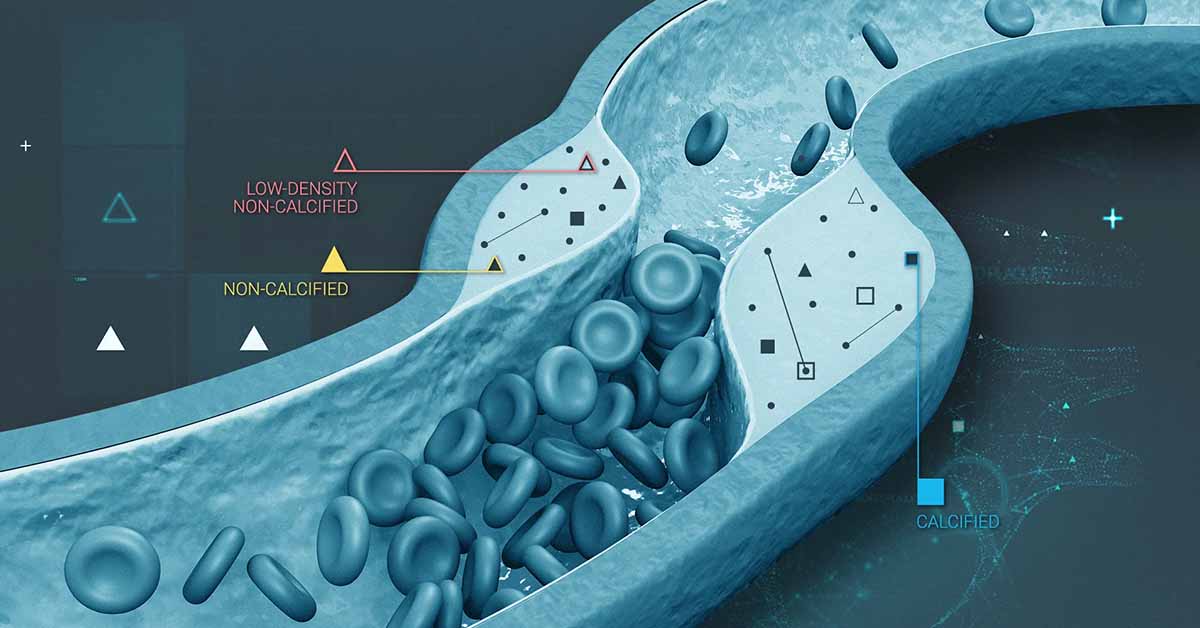The Recipe to a Healthy Heart:Your Guide to Preventing Heart Disease
Sure, the taste of food is important, but do you know how your diet impacts your heart? Many foods contain hidden ingredients that negatively impact...

Heart plaques, which are the build-up of substances like cholesterol and fat in the heart’s arteries, can increase your risk of heart attack. A non-invasive Cleerly analysis can measure your plaque volume and types to help personalize your whole heart treatment plan.
Plaque is the build-up of substances, such as cholesterol and fat, in the heart’s arteries. Arteries are the vessels that carry blood to the heart. Having plaque is called atherosclerosis, and can prevent proper blood flow to the heart as well as put a person at risk of heart attack or stroke.
Understanding the types and volume of plaque in your arteries can reveal your personal risk of coronary artery disease (CAD). CAD is the most common type of heart disease and causes over 380,000 heart attack deaths every year in the United States.1
Coronary plaques are classified into three different categories: calcified, non-calcified, and low-density non-calcified plaques.
Low-density non-calcified plaques, also referred to as high-risk or soft plaques, are made up of fat and connective (fibrous) tissue and are often the most dangerous.
Non-calcified plaques contain fibrous tissues and have some risk to the patient, but not as much as low-density non-calcified plaques.2
Calcified plaques are composed mostly of calcium and are the least likely to cause a plaque rupture or heart attack.
Low-density non-calcified plaques are the most dangerous plaques due to their higher likelihood to rupture. When a plaque ruptures, it can cause a blood clot. This blood clot blocks blood flow to the heart muscle and causes chest pain, a heart attack, or death in some cases.
Non-calcified plaques are not as prone to rupture as low-density plaques but can still cause a rupture or blockage in the arteries if left untreated. Calcified plaques are the least likely to cause a rupture or blockage as they are more stable than non-calcified and low-density non-calcified plaques.
While the causes for atherosclerosis are not fully understood, it occurs when substances carried by the blood (such as cholesterol, fat, and calcium) accumulate in the walls of the arteries. These deposits can cause inflammation when white blood cells try to remove the foreign substances as part of the body’s protective response to keep itself healthy.3
Indicators that a person is at higher risk of plaque buildup in the heart’s arteries may include:
People are also at higher risk of atherosclerosis as they age, especially for individuals over 55.4
Atherosclerosis is a disease that often does not cause symptoms until it is very advanced. Because of this, it is critical that medical providers and individuals regularly examine their risk.
Traditionally, heart disease was screened by looking at health measurements such as blood pressure and cholesterol levels. However, while these can be indicators of heart disease, these are not fully accurate ways to determine if a person has plaque in their arteries. For example, a person with normal levels of cholesterol can still have atherosclerosis, and those who have high cholesterol may not have heart disease.
One of the best ways to understand if the arteries contain plaque is through a test called coronary computed tomography angiography (CCTA). A CCTA is a non-invasive scan of the heart’s arteries that creates 3-D renderings of the heart and coronary arteries. The images from a CCTA can be used by doctors to identify plaque and the types of plaque in the heart’s arteries. The interpretation of a CCTA scan is a specialized skill that may require software that can summarize the results.
Cleerly Labs is an FDA-cleared software designed to make CCTA results easy to understand for both physicians and patients. The AI-enabled technology evaluates CCTA scans using an algorithm based on over 40,000 patient images and multiple clinical trials. Cleerly then produces a report that shows the volume of plaque in the arteries and which types of plaque are present. Cleerly can also be used to compare CCTA scans over time to determine the efficacy of treatment, for example if the plaque continues to accumulate over time, the patient may be on a non-optimal medication dose or perhaps a different type of medication would be more useful.
After a doctor determines a person has plaque in their arteries, treatments may vary based on the severity and amount of plaque. Those with small amounts of plaque or less dangerous plaque may first try changing lifestyle habits, such as improved diet or increased exercise, to see if their levels of high-risk plaque improve.
Doctors can also prescribe medications, such as statins, to help treat plaque. These medications work by helping transform high-risk low-density and non-calcified plaque into lower risk, calcified plaque.
In the most severe cases, such as when the artery is severely narrowed by plaque, a doctor may recommend more invasive treatment methods, such as the placement of a stent to help keep the walls of the artery open.
Providers may reference clinical guidelines or other literature, such as the Atherosclerosis Treatment Algorithms, proposed by the Innovations in Prevention Working Group of the American College of Cardiology, to develop treatment plans for patients with heart plaque. These guidelines use a staging system to define the severity of disease and what measures could be taken to prevent a heart attack.
Cleerly was founded on the mission to create a world without heart attacks. Our AI-enabled software simplifies heart scans into an easily understood report that both doctors and patients can use to define coronary artery disease risk. To learn more about how Cleerly is changing the paradigm of heart care and improving heart attack prevention, subscribe to our newsletter.
References:
1. Heart Disease Facts. ⇱ Center for Disease Control. Accessed March 29, 2023.
2. Low-Attenuation Noncalcified Plaque on Coronary Computed Tomography Angiography Predicts Myocardial Infarction. ⇱ Circulation. March 2020.
3. Leukocyte behavior in atherosclerosis, myocardial infarction, and heart failure. ⇱ Science. January 2013.
4. Noncalcified Coronary Plaque Volumes in Healthy People With a Family History of Early Onset Coronary Artery Disease. ⇱ Circulation: Cardiovascular Imaging. February 2014

Sure, the taste of food is important, but do you know how your diet impacts your heart? Many foods contain hidden ingredients that negatively impact...

As we reach the end of 2023 and yet another remarkable year at Cleerly, it’s a great opportunity to reflect on all we’ve accomplished and begin...

Cleerly has had a busy few months – attending conferences, panel sessions, and winning awards as we all work together to achieve our mission of a...

According to the American Heart Association (AHA), nearly half of Americans have some type of cardiovascular disease.1 Despite such wide prevalence,...

"It's very scary because I had a lot of patients and even friends and neighbors that had heart attacks, and we thought they were healthy by eating...

Both coronary artery calcium score (CACS) and Cleerly evaluate heart disease risk using cardiac imaging. Learn about the key differences between the...